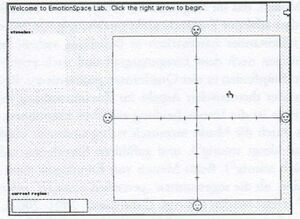Version vom 2. März 2022, 20:32 Uhr
Information zur Nachricht (bearbeiten ) Zu dieser Nachricht ist keine Dokumentation vorhanden.
Sofern du weißt, wo und in welchem Zusammenhang sie genutzt wird, kannst du anderen Übersetzern bei ihrer Arbeit helfen, indem du eine Dokumentation hinzufügst.
Nachricht im Original (Bisherige "continuous response" - Systeme )
=== EmotionSpace Lab ===
=== EmotionSpace Lab ===
[[Datei:EmotionSpace-Lab.jpg|mini|Abbildung 3.1: Emotion Space Lab (Kopiez et al. 2011, S. 132)]]
Das EmotionSpace Lab (ESL) wurde 1996 von dem australischen Musikpsychologen Emery Schubert entwickelt und ist das erste Programm, das den 2DES verwendet. Die Steuerung funktioniert mit der Maus. Smileys zur Verdeutlichung sind jeweils an den Enden der Achsen vorhanden und visuelle Stimuli können neben dem Emotionsraum gezeigt werden. Zusätzlich zum Cursor wird, wie in Abbildung 3.1 zu sehen ist, unten links die horizontale Position visualisiert. Die Achsen sind gleichskaliert, die Valenz wird horizontal angegeben, die Aktivität vertikal. Als Stimuli sind neben Audiodateien Wörter und Bilder möglich, die neben dem 2DES angezeigt werden (Kopiez et al. 2011, S. 132f.). Das ESL verwendet eine Sample-Rate von 2 Hz, also zwei Samples pro Sekunde. Dies wurde damit begründet, dass die Veränderungen in der Aktivitätseinschätzung als Reaktion auf Lautstärkeveränderungen erst 1-3 Sekunden nach dem akustischen Ereignis auftraten. Nach dem Nyquist-Shannonschen Abtasttheorem (Benson 2007, S. 254f.) muss die Sample-Rate mind. doppelt so hoch sein wie die zu erwartende Frequenz des Signals, also zwei Samples pro Sekunde um sekundengenau auswerten zu können (Schubert 2010, S. 225). Übersetzung === EmotionSpace Lab === EmotionSpace Lab Figure 3.1: Emotion Space Lab (Kopiez et al. 2011, p. 132)
EmotionSpace Lab (ESL) was developed in 1996 by Australian music psychologist Emery Schubert and is the first program to use 2DES. The control works with the mouse. Smileys for clarification are provided at each end of the axes, and visual stimuli can be shown next to the emotion space. In addition to the cursor, the horizontal position is visualized at the bottom left, as shown in Figure 3.1. The axes are scaled equally, valence is indicated horizontally, and activity is indicated vertically. Possible stimuli are words and pictures in addition to audio files, which are displayed next to the 2DES (Kopiez et al. 2011, p. 132f.). The ESL uses a sample rate of 2 Hz, or two samples per second. This was justified by the fact that changes in activity estimation in response to volume changes occurred only 1-3 seconds after the acoustic event. According to the Nyquist-Shannon sampling theorem (Benson 2007, p. 254f.), the sample rate must be at least twice as high as the expected frequency of the signal, i.e. two samples per second, in order to be able to evaluate with second precision (Schubert 2010, p. 225).
